Posts tagged Rex
2009 New Orleans Mardi Gras Parade Rankings
0MUSES
1. Muses had the best throws by a mile. No other krewe is anywhere close to catching Muses. I’m recording short videos for the blog of two of the throws- the round mirrored medallion with the multi-colored light show and the ‘fan’ with the Muses light show. Here’s a listing from the New Orleans freecycle group that I received yesterday:
seek to borrow -Muses Light-up rings
Our dance group needs about 15 of the rings that were thrown at the Muses Parade for props. We will return them. We need them by Wednesday. Thanks.. Muses throws have become part of a dance performance. The hand decorated shoe has moved up in stature as a throw and now rivals the Zulu coconut, although I haven’t heard about Obama receiving a Muses shoe like he received a coconut and met with the King and Queen of Zulu! Muses dancing groups are second to none, except for possibly the Krewe du Vieux, who parade outside the formal 10 day Parade Season recognized by these rankings. Muses is big on satire, and their bands, floats krewe member’s generosity are good enough to swing this all-female krewe, only 8 years old, to the NUMBER ONE RANKING!
D’ETAT
2. D’Etat earns the number 2 ranking for several reasons, including their top throw- a 360 degree 3-D full color cup, using lenticular technology. I didn’t see anything like this anywhere else during the Carnival season during the parades. I know the Giacona Company in Jefferson sells a cup like this. D’Etat out-promoted other krewes, with two different fliers on the parade route. D’Etat was built by Royal Artists, the preferred historic paper mache experts. Royal’s floats wobble and shimmy, creating movement in the paper mache props. Their satire was effective, even if most of the satirical krewes poked fun at many of the same entities- the economy, city council, mayor, etc.

ENDYMION
3. Endymion is the people’s choice for best parade every year, since they have the biggest crowd without fail. Endymion has more riders on the biggest floats and more throws (volume) with the biggest float props. Endymion has St. Augustine High School Band leading off, and that is surely the mark of band excellence. Endymion on an average year is still almost the best parade in Carnival. They use the propane flambeaux, which burn at a lower temperature than the kerosene models, and therefore don’t produce the same high intensity light that the historic models achieve. Historically, the flambeaux illuminate the night parade, and the smoke from the flambeaux adds to the parade’s mystique. The propane flambeaux burn cleanly, so the smoke was lacking.
BACCHUS
4. Bacchus is the original Super Krewe, and they had all the pieces- the icon floats, the huge membership, lots of throws, and numerous notable bands. Throwing beads at the Kongs is the only time NOPD allows throwing at the floats. The Bacchasaurus, Bacchawhoppa, and Bacchagator never disappoint the crowd. St. Augustine led off Bacchus, that helps raise a rating. The Bacchus crowd along St. Charles Avenue a few blocks from Napoleon seemed very well behaved and not as big as I remembered, and Bacchus closes out a big second Sunday of parades. Okeanos, Mid-City and Thoth all preceded Bacchus on Sunday.
REX
5. Rex is the King of Carnival, and they are a perennial top 5 parade. But rarely are they as low as 5, and there is a reason the School of Design (Rex’s organization) in 2009 gets that rating. They ran out of bands! The entire second half of the parade didn’t have the requisite one float/one band ratio, but 2-3 floats/band! To huge Rex fans like myself, this is embarrassing. I never imagined Rex with so few bands.
Rex is a Blaine Kern production, and the floats looked divine as they should in the sun. Rex is the only Super Krewe to use wooden wagon chassis and wheels. This limits the size of their floats to historic dimensions. Rex didn’t disappoint with the heavier 50th Anniversary doubloon. Thoth also threw a heavier weight doubloon. Rex was the first krewe to throw doubloons 50 years ago after Alvin Sharpe approached the krewe.
They were very selective with the large plush boeuf gras, and a little less so with the smaller boeuf gras. They had a host of different medallion beads, all of them purple, green and gold. Rex stayed with their old medallion longer than any other krewe. Rex didn’t have a light up medallion bead, as Proteus had. In the recent past I caught a plush green crown from Rex, but that throw wasn’t evident this year.
2009 New Orleans Mardi Gras Wrap Up
3Carnival 2009 was noteworthy in some respects. For example, the only cold weather of the season occurred during the second Carnival weekend, not the first weekend. 2009 was the 100th anniversary of the Zulu organization, and was also the 50th anniversary of the Mardi Gras Doubloon, an anodized aluminum ‘coin’ that had the krewe logo on one side and the parade theme on the other. Rex was the first krewe to throw doubloons 50 years ago. The doubloon also changed the economics of krewes- it was the first throw that the krewe could sell to its members for a small profit, thereby adding a important revenue source for all krewes. 2009 was the year that electric light up beads became almost commonplace.
ORLEANS PARISH PARADE SUMMARY
Pre-Season:
Krewe du Vieux: KdV was big, brash, and more biting than anyone else (rated M for mature) in its satire. The floats are mule drawn, and they have more brass bands than anyone else- seventeen in 2009. They are the only krewe to march in the French Quarter and Faubourg Marigny. KdV is the only adult themed krewe to march down the streets of New Orleans. I love KdV but I’m partial because I am in KdV.
First Weekend:
Oshun, Pygmalion and Ponchartain are small parades, but the first of the season to travel down St. Charles Avenue, and therefore very very welcome. Ponchartrain used to parade in the Lakeview area. I’ve always loved their giant crawfish float. Sparta looked different this year. They had bigger floats and didn’t look as historic as in the past. Sparta is the first krewe each season to use traditional kerosene fueled flambeaux. Pegasus is an open krewe that allows the public to join the krewe, ride in the parade, and attend krewe events and parties. Carrollton and King Arthur on the first Sunday are the only parades down St. Charles Avenue that day making it a very short weekend parade day.
Weekday Parades:
Babylon is the fully traditional parade of the season, and they were celebrating their 70th anniversary in 2009. Babylon has the look and feel of an old fashioned parade from a century ago. Many of their paper mache floats ride on wood wagon chassis and wooden wagon wheels and they utilize the original flambeaux made for Rex and Comus a long time ago.
Muses, an all-female krewe, was simply the best parade of the season for a number of reasons:their huge advantage in the type and variety of their throws, their emphasis on the woman’s shoe as krewe emblem, and their far out marching groups like the Rolling Elvi, the Camel Toed Lady Steppers, Pussyfooters, and Bearded Oysters. A great article on the groups can be found in Where Y’at Magazine’s web site here . Muses has established their hand decorated woman’s shoe throw on a level that approaches the Zulu coconut.
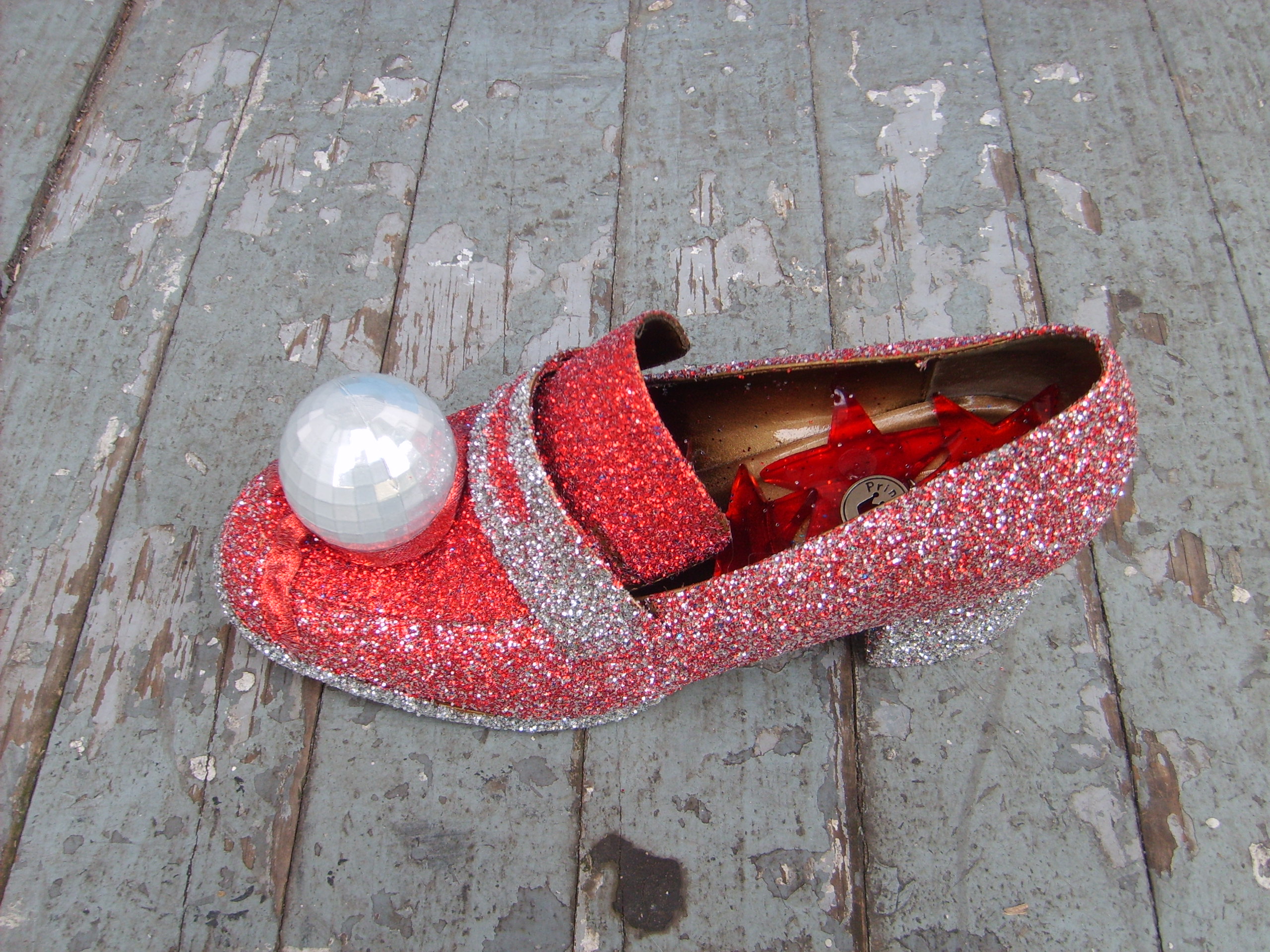
Chaos utilized a relatively new kerosene flambeaux that are not part of the original set made for the old krewes in the late 1800s. The older krewes wouldn’t allow newer krewes to use their original flambeaux, so an ingenious and crafty krewe Captain studied the original flambeaux and created very close copies that work similarly but apparently don’t violate any patent. Chaos was the first parade this season whose floats were made by Royal Artists, who make the some of the best traditional paper mache floats in all of Mardi Gras. Check out Royal Artists’ web site here . Hermes was the first parade on a three parade night, and the floats were made by Royal Artists, giving the parade a traditional paper mache look. Hermes utilizes the older flambeaux. D’Etat goes all out to promote their parade, putting up two different fliers on poles throughout the parade route. D’Etat was one of the very first krewes to toss large numbers of light up beads, one of the biggest trends in Carnival throws. E’tat had a really good looking 3-D krewe cup, the only 3-D cup that I saw all parade season. The 3-D cup uses lenticular technology. Morpheus also used the longer route, following D’Etat. Morpheus is only 8 years old, but they have a traditional look to them. The painting on Morpheus’ floats was different than the other krewes, and I found the style simple but pleasing.
2nd Weekend Parades:
Iris is the oldest of the two all-female parading krewes, Muses being the other. Iris favors children with their throws. Tucks was formed by Loyola college students a few decades ago, and have kept their irreverent attitude. Their unique toilet float has been updated into the King’s float, keeping the porcelain fixture intact.
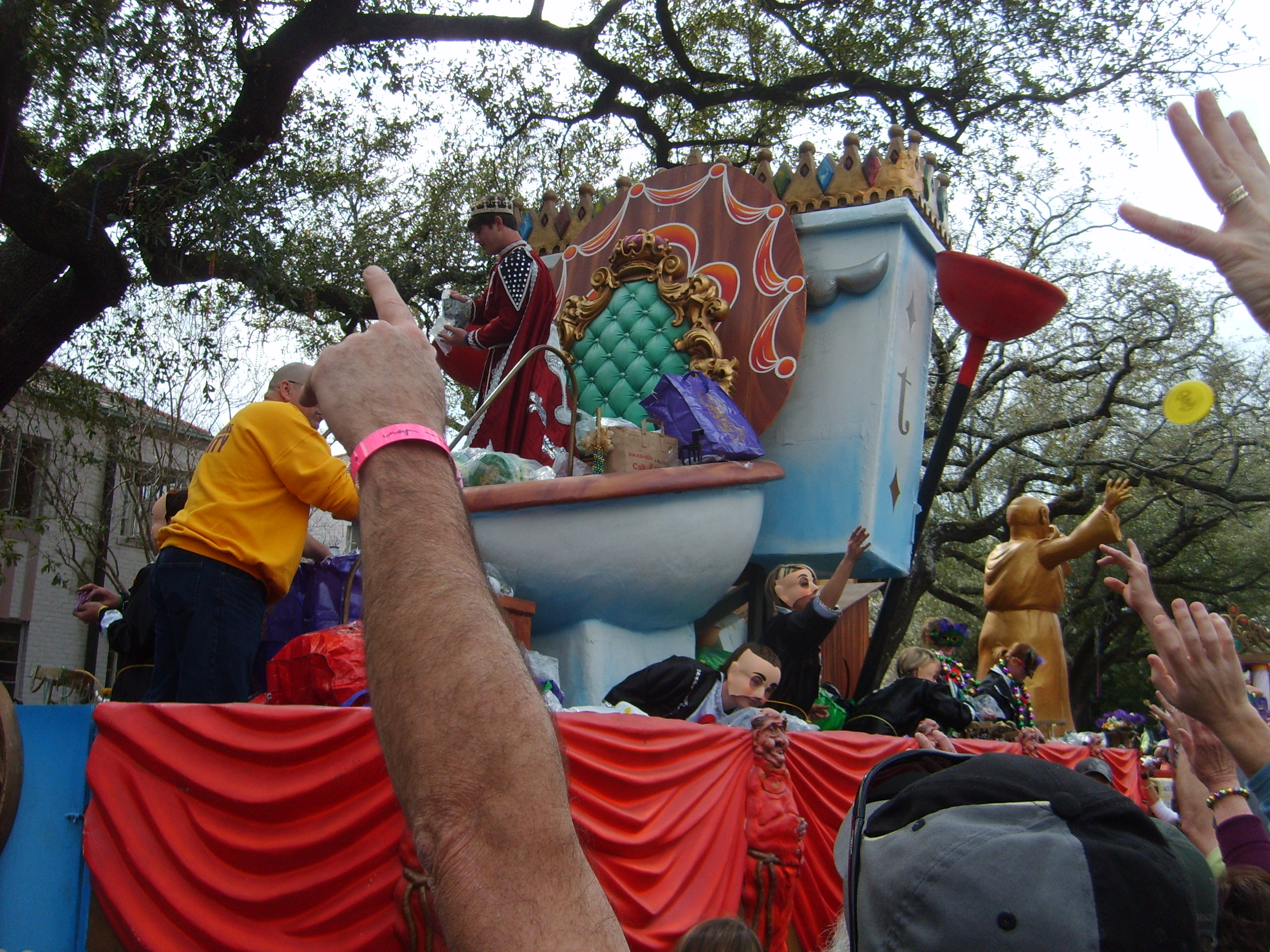
One of the reasons I love Tucks is because I had my own float in Tucks for three years, at a time when Tucks solicited for floats to augment their parade.
Endymion is the biggest of all ‘super krewes’ with over 2,000 riders. Kid Rock was their celebrity king, and before the parade, at the big Endymion block party, Kid Rock reprised his big summer hit, Sweet Home Alabama before a huge crowd. Endymion has the most riders, the biggest floats, the most throws, terrific bands, and the biggest crowds. Endymion began as a neighborhood parade in 1966, and morphed into a super krewe in 1974. They utilize a third type of flambeaux, a propane version.The original flambeaux design burns kerosene, and the system has always leaked. The kerosene is stored in a tank above the head of the flambeaux and gravity carries it down to the burners. I’m not sure who owns these.Okeanos celebrated their 60th anniversary this year. New this year, several krewes that historically started on Napoleon Avenue began their routes at Jefferson and Magazine Streets. Okeanos was the first to try out the route addition. Mid-City was the first parade to use colored foil to decorate their floats, and when the sun is shining, Mid-City’s floats look superlative. Mid-City has an old tradition, the “Greatest Bands in Dixie” contest for the bands that participate in the parade.
Thoth has their own extra long route uptown, as they parade past hospitals and retirement homes. Thoth looked better than usual. In the past they rented their floats from Hermes, and many times, their floats didn’t match the float titles. This year, they had better looking floats that weren’t Hermes.

Bacchus, the original super krewe, was formed in 1968 as a super krewe. To our eyes, Bacchus looked a little smaller in 2009. Bacchus was the first krewe to have a celebrity king each year, and they originated the huge super floats that contain dozens and dozens of riders. Today, there are 4 super krewes in New Orleans- Bacchus, Endymion, Rex, and Orpheus. On the West Bank, Alla qualifies as a super krewe, and in Metairie, Caesar does.
Monday Night Parades:
Proteus began parading in 1881. They use the old wooden wagon chassis and wagon wheels, and the traditional flambeaux they started with over a century ago. I caught a light up seahorse medallion at the parade this year. Proteus is a good looking, traditional paper mache parade built by Royal Artists. The only two parading krewes from the 1800s now are Proteus and Rex. Comus, who began parading in 1857, and Momus, who started in 1872, stopped parading in 1992 after the New Orleans City Council, led by Dorothy Mae Taylor, passed an anti-discrimination ordinance. Proteus stopped parading at this time, but resumed parading in their old Monday night slot in 2000. Orpheus, the super krewe founded by singer/actor Harry Connick, Jr., looked a little less super in 2009. For one thing, after the first few floats, the bands ran out. Super Krewes find enough bands no matter what. While many of their floats were giant, gorgeous creations, many others were ordinary.
Mardi Gras Day Parades:
Zulu celebrated their 100th anniversary in 2009, and to celebrate, their parade, perennially late, was actually early! That is a really big deal for Zulu. I received 5 coconuts after 1/2 of Zulu, which is more than I’ve ever received in over 30 Zulu parades. Today’s Zulu coconuts are improved, 4 of the 5 coconuts I received had the milk and meat removed. If you leave the milk and meat, the coconut often rots. Zulu led off their parade with the Edna Karr High School Band, which was a big switch. Historically, Karr hasn’t been known for leading off Zulu, but in this post-Katrina New Orleans, anything can happen. Rex, King of Carnival, was the first krewe to throw doubloons 50 years ago. Legend has it that Alvin Sharpe, inventor of the Mardi Gras Doubloon, proved the doubloon were safe enough to throw from the floats by tossing a handful at the Rex Captain’s face. When he was unhurt, the doubloon was launched into Mardi Gras throw history. The organization that puts on the Rex parade in called the School of Design. The line of throws thrown by Rex increased in recent years. Historically, Rex threw one type of medallion. This year, they had numerous varieties of logo beads, and two sizes of plush Boeuf Gras. In 2009, Rex didn’t look quite as royal as the King of Carnival should. They too suffered from a bad float/band ratio. Yes, it’s the end of Carnival, but Rex has surmounted this problem before, and I’m surprised and disappointed that they couldn’t obtain even close to enough bands. On St. Charles Avenue a few blocks from Napoleon Avenue, the crowd was lighter than usual. The crowd over the weekend on Bacchus Sunday was noticeably bigger. Yet there is no parade like Rex. They alone have the Boeuf Gras and Jester floats. These floats, along with the Rex King’s float, are the symbols of Carnival in New Orleans the world over.
Mardi Gras Day Wrap Up
0Mayor Nagin led Zulu this morning down Jackson Avenue on horseback. Zulu, celebrating its 100th anniversary, was early for the first time in recent memory. Nagin was wearing a Roman leather gladiator costume with no sleeves. I received 5 coconuts after the 12 or so Duke, Maid, past King/Queen, and Special Zulu position floats. My favorite coconut this year is from the “Big Shot Crew” (see picture below). In the past, Zulu coconuts came with the coconut milk intact. Now, the milk is removed on most of the coconuts, which helps preserve them.
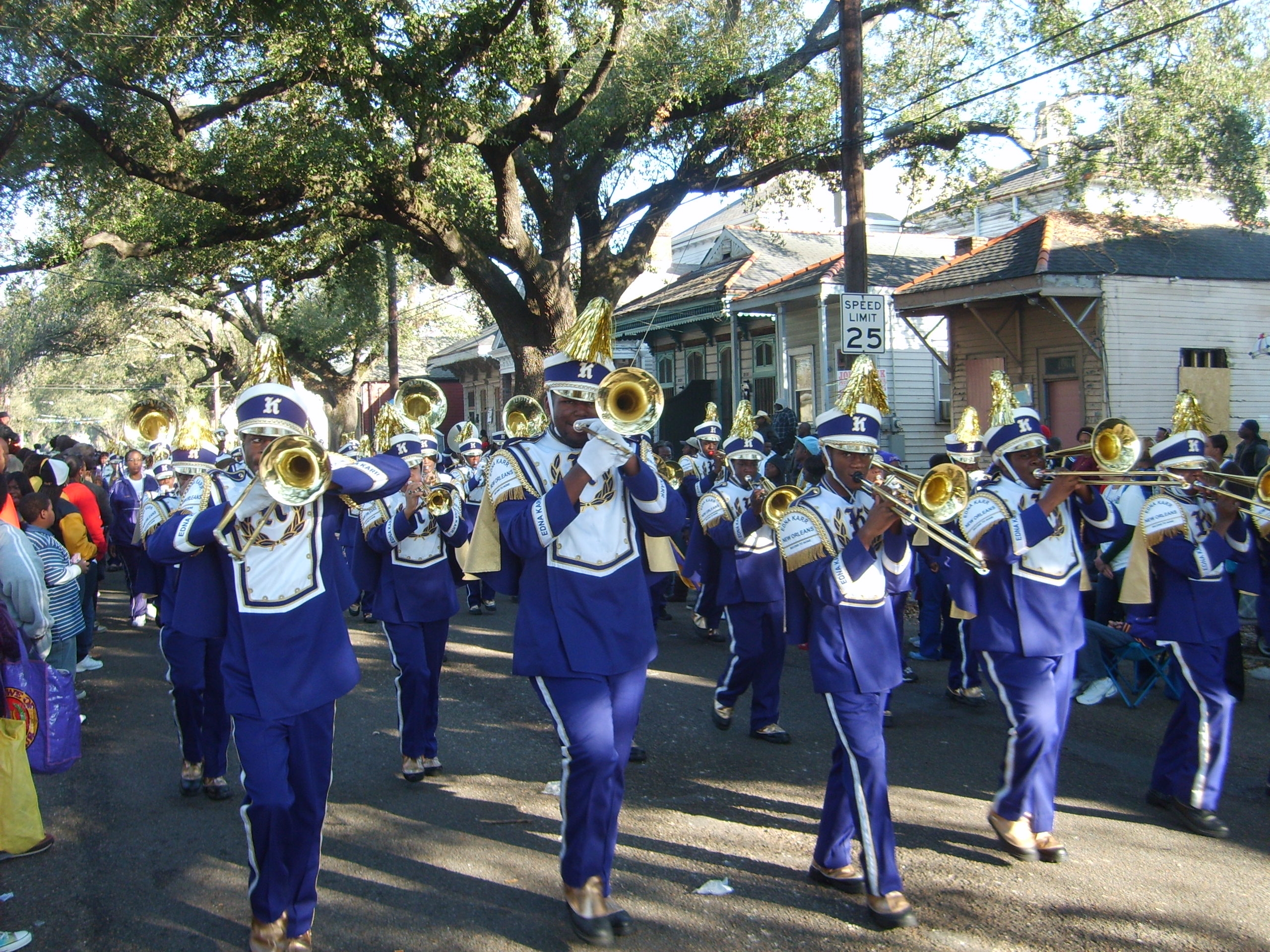
Zulu was led by New Orleans’ own Edna Karr High School. Since Katrina, there has been a change, mostly for the better, in high school marching bands. Edna Karr leading Zulu typifies this change. In the past, Edna Karr and Sara T. Reed’s bands were indifferent. Now they are approaching the same league as perennial powerhouses St. Augustine, McDonough 35, and in the female high schools, St. Mary Academy and Xavier Prep.
I borrowed my son’s bicycle to travel from my parade headquarters on St. Charles Avenue to Jackson Avenue. I left Zulu when it was half over as I wanted time with my wife to see the sights on St. Charles Avenue before Rex.
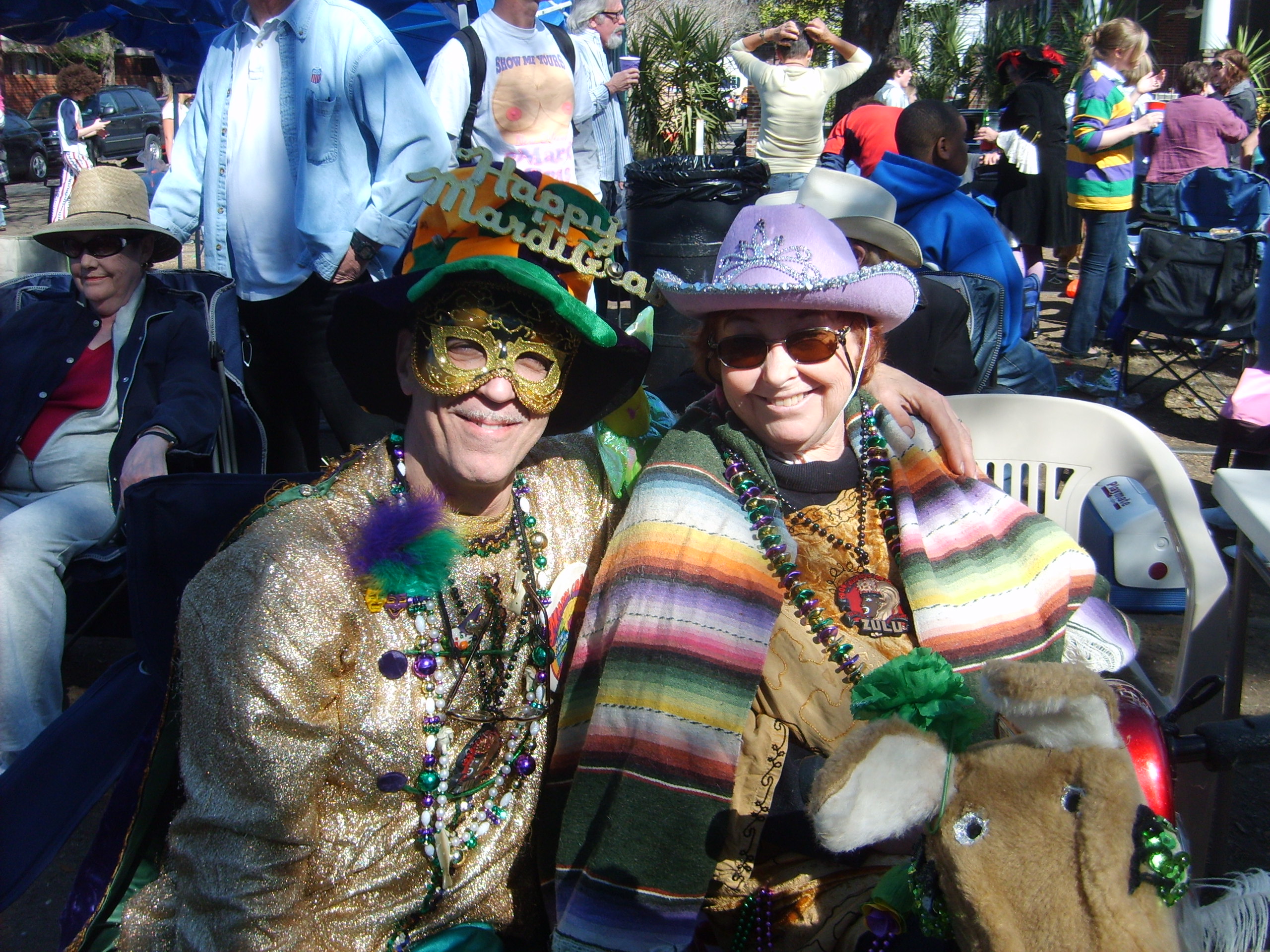
The crowd for Rex on St. Charles avenue between Napoleon and Louisiana Avenues was relatively light. This was very unexpected. It was heavier over the weekend, especially on Bacchus Sunday. Bacchus Sunday is an all day affair, with parades from 11 am through 9 pm. Mardi Gras Day is from around 7 am to around 1 or 2 pm, when the trucks finish uptown.
One of the coolest aspects of Rex is they are one of only two krewes that utilize wooden wagon wheels on wooden float carriages. Proteus the day before Rex is the only other krewe using old wooden wagons with wood-spoked wheels.
The newest float beds of the older two krewes, ironically, belong to his majesty Rex, built in 1951 after the old Rex den on Calliope Street burned. The most unusual Carnival wheels that require a wheelwright are the light carriage wheels belong to the krewe of Napoleon’s mini-floats; these are built on the beds of buggies purchased from a French Quarter carriage company.
Who maintains the wooden wheels? You need a master wheelwright, and the last one I knew who maintained the wheels for the oldest krewes was Earl Wyman. He’s long gone, so who does that job now? There are no listings for master wheelwrights in the New Orleans Yellow Pages.
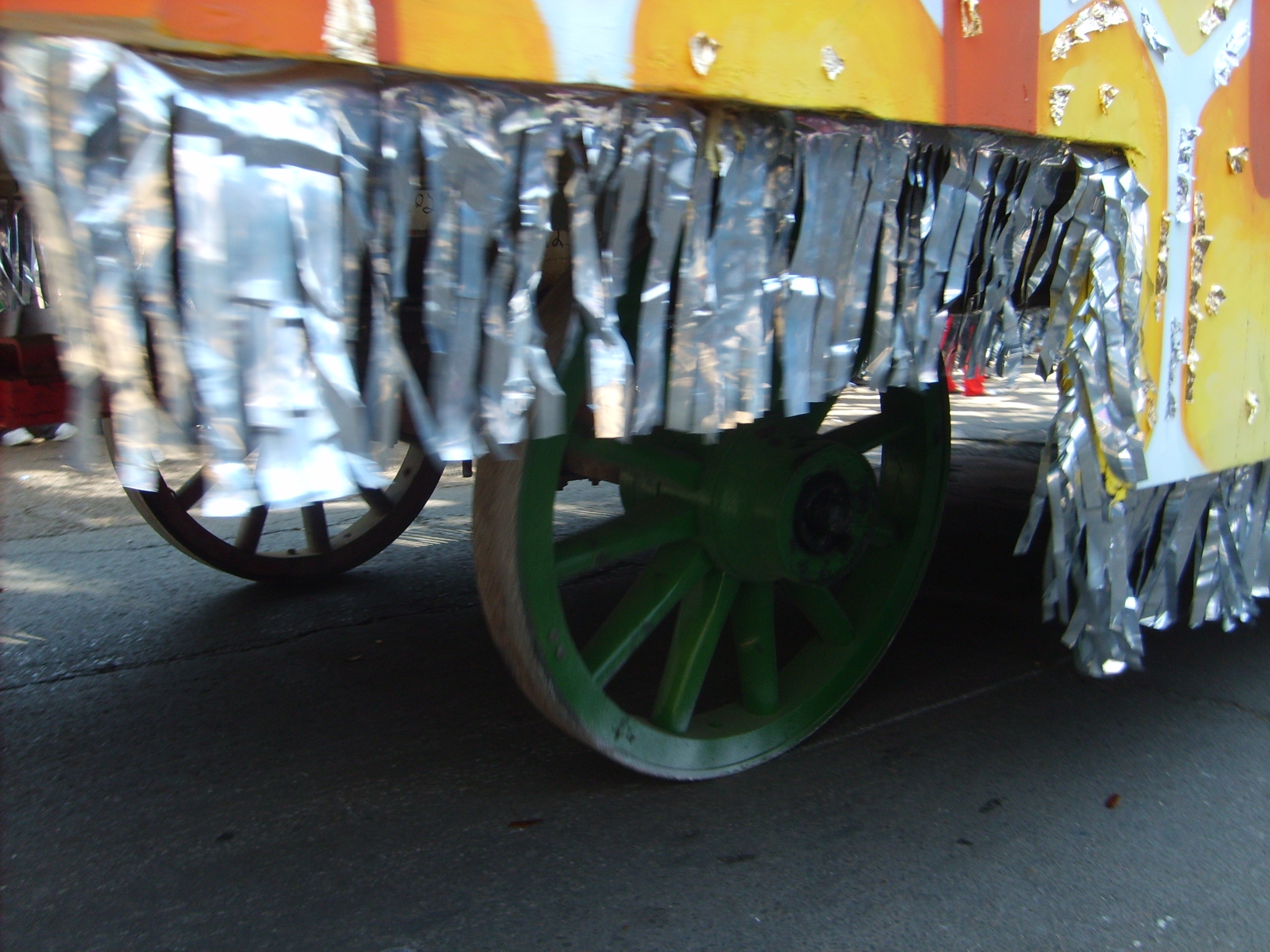

Rex has followed the recent trend of most New Orleans parading krewes of broadening out their throw selection. Rex has thrown plush Boeuf Gras the last few years. This year, they also threw a very large plush Boeuf Gras. For dozens of years, Rex threw a very basic, bland medallion. Now they have an entire line of Rex beads and medallions. They have thrown a standard 16 oz cup for years and now they have a second, more colorful, larger cup.
Two of my favorite throws I caught for 2009 (see photo) were a Muses decorated shoe and the Big Shot Crew Zulu coconut. Muses had an couple of wild electric logo toys- a round mirror with lights and a fan that doesn’t cool very well but provides a very entertaining light show with the Muses name revolving and appearing & disappearing. 
Muses was once again the clear leader in number of innovative throws. Here’s a partial list of throws that I found on Craigslist for sale on Monday, February 23:
The “Top Secret” throw, a poster sized print up with a description and likeness of all their floats, and amusing writings on each float.
A shoe bracelet in the colors of silver, red and black.
A light up crystal necklace that blinks and is heart shaped. Still sealed in package, with an “M” on it.
A light up blinking bead still sealed. It says “Muses 009 License to Swill” on it.
A stuffed alligator with Muses written on it.
A hard to get hand-held fan to cool you off in summer. When the soft blades go around the word “Muses” lights up and revolves several ways. Very cool.
Muses bead maze games.
A Muses street sign bead.
A light up ring, just twist to activate blinking.
Combination light up flashlight/bottle opener.
And the big prize throw- the highly coveted radio, including neckstrap, ear buds, and automatically scans to pick up all stations.
History of Mardi Gras
2

March 7, 1885 Harper's Weekly illustration, , artist John Durkin. Art courtesy of Historic New Orleans Collection
Mardi Gras – Fat Tuesday – is the day before Lent begins. In 1512, the Butchers’ Guild of Paris created the tradition of leading a fattened ox, the “Boeuf Gras”, through the streets to celebrate the last feast before the rigors of Lent.
In its earliest form, Mardi Gras is probably linked to pagan rites celebrating the return of spring. Ancient Rome’s Lupercalia, a lusty fertility festival, was celebrated yearly on February 15. The young Catholic Church, unable to obliterate the pagan festivals, adopted and purified many: Carnival as a pre-Lenten celebration was born.
Pierre LeMoyne Sieur d’Iberville, arriving at the Mississippi River on Mardi Gras eve, 1699, named his encampment “Bayou and Pointe de Mardi Gras.” In the 1700’s, the French settlers continued to celebrate Mardi Gras.
Masquerades were regulated on a discretionary basis during the years Spain ruled New Orleans. Whenever the peace was threatened, a short-term police ban on masking was invoked. Balls, rather than parades, were favored. The Quadroon balls, known for their beautiful women, and most spectacular during Carnival, thrived during the end of the eighteenth and first half of the nineteenth centuries.
Because of the French “Boeuf Gras” tradition, it is safe to assume that New Orleanians paraded before the newspaper accounts of 1837-38, which record the processions of maskers in decorated carriages, on horseback and afoot. Mention of the Mobile, Alabama Cowbellions as Carnival participants also appears in newspapers about this time.
By the 1850’s, troublemakers had invaded the ranks of the maskers and were tossing dirt, flour, and even lye at the spectators instead of the traditional dragees (sugar coated fruits and nuts) and bon-bons, leading to a city ordinance against the “throws” and a proposed ban on parading. While Mardi Gras parades were declining in quality, there were definite bright spots; the carefully planned 1852 parade by the Company of Bedouins is considered the finest prior to Comus.
The parades of 1855 and 1856 were especially bleak, but events were taking place that would vastly improve Carnival. In the early 1850’s, a number of individuals from Mobile moved to New Orleans. Some of them had been members of the Mobile Cowbellion De Rakin Society, the first parading New Year’s Eve club. They missed the New Year’s Eve parades back home, and after experiencing a few of the New Orleans Mardi Gras processions, decided to form a secret Mardi Gras club in New Orleans similar to Mobile’s New Year’s Eve organizations.
Led by Joseph Ellison and Thad Smith, they obtained costumes from the Cowbellions and the Strikers Independent Society (another Mobile club) for their new Carnival parade in New Orleans. Thus the Mistick Krewe of Comus was born, legitimizing New Orleans Mardi Gras parades. Attended by torch bearers, Comus rode on one float, Satan on another, and approximately 75 devil maskers cavorted on foot.
After the Civil War, during Reconstruction, the Twelfth Night Revelers (1870), Rex, and Momus (both 1872) were formed. Rex introduced daytime parading to Carnival. Ten years later, Proteus was organized, followed by the Jefferson City Buzzards (a marching club) in 1890. Zulu, a black krewe, originally a spoof of Rex, was formed in 1909.
Alla, Mid-City, Hermes, and the first truck parade, the Elks Orleanians, began in the 1930’s, and the first parading women’s krewe, Venus, preceded World War II. After the war, many new organizations, the majority from the suburbs, began parading. The number of major parades doubled and tripled, reaching a high of more than fifty.
In the early 1950’s, mules were phased out of float pulling, being replaced by tractors. 1960 saw the birth of a major new throw, the aluminum doubloon. Carnival 1969 was the inaugural parade of Bacchus, the first krewe to have jumbo “Super Floats” and a celebrity non-local King.
The krewe of Mardi Gras first used decorated paper cups as a throw in 1975. The next year, Alla introduced a decorated plastic cup, which for a couple of decades became the most popular throw. That cup was made by a local company, Giacona Container Corp.
1979 was the year of the infamous Orleans Parish Police strike, resulting in the cancellation of most major Orleans parades and the temporary move of others to the suburbs. Carnival recovered from this ordeal
Momus, Comus and Proteus stopped parading in the 1990’s, but continue to hold masked balls. Proteus returned to the parade route a number of years later. It is said that a number of Comus and Momus members ride in a relatively new parade, Chaos.
The 1990’s saw the diversification of throws, including a wider assortment of small toys, and a huge assortment of stuffed animals, and some new throws, including lighted beads. Doubloons have lost some favor, but still exist in small numbers. In the last few years, a number of krewes throughout the metro New Orleans area have stopped parading. The reasons are many, including a shortage of krewe members, and the high cost of krewe dues, throws, and parade insurance.
The new century saw a standardization of parade routes, with most krewes rolling down St. Charles Avenue. August 29, 2005 brought Hurricane Katrina, which severely impacted Carnival. The season was shortened by 20%, less parades rolled, the parades were shorter with less floats and bands. Many hotel rooms were not available.
Want to know more about the history and traditions of the New Orleans Mardi Gras? Read these fine books: Mardi Gras, by Robert Tallant (Doubleday & Co.,1949); New Orleans Masquerade: Chronicles of Carnival, by Arthur Burton LaCour (Pelican Publishing Co.,1952); Mardi Gras! A Celebration, by Mitchell Osborne and Errol Laborde (Picayune Press, 1981); The Mistick Krewe, by Perry Young, (Carnival Press, 1931); and If Ever I Cease to Love: One Hundred Years of Rex, by Charles Dufour (School of Design, 1970).
Famous Parades Past: Comus 1873 Momus 1877
0 Think Krewe du Vieux or Krewe d’Etat are the most satirical? How about Muses and Momus? Consider these New Orleans parades from long ago.
Think Krewe du Vieux or Krewe d’Etat are the most satirical? How about Muses and Momus? Consider these New Orleans parades from long ago.
Two 1870s parades are famous for the controversy they created concerning the big issue of the day, Reconstruction.
The 1873 Comus procession titled “The Missing Links to Darwin’s Origin of the Species” and the 1877 Momus parade named “Hades – A Dream of Momus” ridiculed the carpetbaggers who ravaged the war torn South in the decade following the Civil War.
New Orleans was a troubled city during the Reconstruction era, and by 1873 on Carnival Krewe had enough. The members of Comus, behind the relative security of their masks, decided to let their feelings known. The 1873 Comus procession was noteworthy for a second reason – it was the first constructed entirely in New Orleans, all others having been at least partially built in France.
But it is the satirical aspects of this Comus parade that are best remembered. Comus ended the tradition of political neutrality with a flourish, depicting the carpetbaggers and Republicans as pests and misfits. President Grant was a boll Weevil. The stir created by the parade was immense, locals loving it and carpetbaggers hating it equally as much.
One year later, in 1974, a major riot occurred on Canal Street between the Metropolitan Police, run by the carpetbaggers, and the White League, the organization of the badgered citizens of New Orleans. The major Carnival parades were cancelled as a result. When 1876 rolled around, the city was again in a desperate condition due to the contested state and federal elections that year.
The two Presidential candidates, Republican Rutherford B. Hayes, and Democrat Samuel J. Tilden, were quarreling over the Presidency and an electoral commission was formed to settle the question. The Louisiana electoral vote was about to go to Hayes, giving the election to the Republican candidate by one vote.
On the state side of the election, two gubernatorial candidates had a similar feud going on. S. B. Packard, the Republican carpetbagger, had the might of the Federal armed forces behind his effort while Francis T. Nicholls, the Democrat, had the support of the populace- he was the a Confederate war hero, having given his left arm in one battle and his left foot in another.
Obviously prepared for the official outcry, Momus paraded on February 8, 1877. They were hours overdue because the floats proved too big for the den doors. When the obstructing wall was finally ripped out, it was 10 pm. The crowd was waiting.
The people’s response was immediate- they loved it! The floats satirized and ridiculed the carpetbagger chiefs and Republican officeholders from the local to the national level, including President Grant. Each float recreated Hades, the abode of the dead, the gloomy subterranean home of departed spirits. The float riders depict the scalawags (white Southern Reconstructionists who acted as Republicans) and other regional and national Republicans as every manner of odd creature imaginable.
With the ensuing Republican outcry rising, and retaliation from Washington a possibility, Nicholls, who had been hoping for official recognition of his victory from the Federal Government, decided to act fast. He wired an apology to the nation’s capital, even though he was a strong supporter of Carnival. Nicholls was afraid that the new President, Hayes, would dash his hopes of keeping the Governorship of Louisiana. Nicholls ended up as Governor, but Momus didn’t utilize satire again until the one hundredth anniversary of this memorable procession. Their return to satirizing local politics and trends was welcome, and they continue to do so.